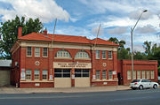
Ambulance Service of New South Wales
Encyclopedia

Government agency
A government or state agency is a permanent or semi-permanent organization in the machinery of government that is responsible for the oversight and administration of specific functions, such as an intelligence agency. There is a notable variety of agency types...
of the Department of Health
New South Wales Department of Health
The New South Wales Department of Health, a department of the New South Wales Government, is responsibile for monitoring the performance of the public health system in New South Wales, particularly through public hospitals...
of the New South Wales Government
Government of New South Wales
The form of the Government of New South Wales is prescribed in its Constitution, which dates from 1856, although it has been amended many times since then...
, is the main provider of pre-hospital emergency care and ambulance services in the state of New South Wales
New South Wales
New South Wales is a state of :Australia, located in the east of the country. It is bordered by Queensland, Victoria and South Australia to the north, south and west respectively. To the east, the state is bordered by the Tasman Sea, which forms part of the Pacific Ocean. New South Wales...
, Australia
Australia
Australia , officially the Commonwealth of Australia, is a country in the Southern Hemisphere comprising the mainland of the Australian continent, the island of Tasmania, and numerous smaller islands in the Indian and Pacific Oceans. It is the world's sixth-largest country by total area...
.
The Service is committed to providing high quality clinical care and health related transport services to over 6.3 million people in NSW, distributed across an area of 801,600 square kilometres.
The service employs more than 4,000 men and women, who work from 266 locations across the State, operating over 1000 ambulance vehicles and 300 support vehicles to provide emergency, non-emergency, aeromedical, rescue
Rescue
Rescue refers to responsive operations that usually involve the saving of life, or prevention of injury during an incident or dangerous situation....
and retrieval services. Around one million responses are made by the service each year.
History
The first recognised ambulance service in New South Wales, known as the Civil Ambulance and Transport Brigade, began on 1 April 1895, however this was pre-dated by the NSW Government Railway Ambulance and First Aid Corps which was set up by Railway Commissioner Goodchap in 1885. The first civil ambulance stationAmbulance station
An ambulance station is a structure or other area set aside for storage of ambulance vehicles, medical equipment, personal protective equipment, and other medical supplies. Most stations are made up of garage bays or a parking area, normally undercover...
was a borrowed police station in Railway Square in Sydney staffed by two permanent officers. Patients were transported on hand-held stretchers and handlitters.
The Brigade was a dedicated community based organisation, operating the first horsedrawn ambulance in 1899 and first motor vehicle in 1912, both donated to the Brigade by the public. Radio controlled vehicles commenced operation in 1937, a rescue service in 1941, a training school in 1961 and air ambulance in 1967. Advanced life support and intensive care vehicles were introduced in 1976.
Ambulance types
As NSW operate a variety of emergency and non emergency vehicles across the state including a number of specialised vehicles such as over-snow vehicles. These vehicles are imported and then fitted out and engineered by Emergency Transport Technology, which employs auto electricians, diesel mechanics, fitters and turners, bodybuilders and other tradesmen to build emergency vehicles, aside from ambulances, these include long-wheelbase Mercedes Benz bomb squad vans and Volkswagen T5 Transporter Police vans.- Emergency medical care Ambulances
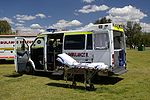
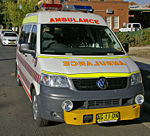
Hard to access areas such as bush or mountainous terrain may require specialist vehicles such as the Toyota Landcruiser Troopcarrier.
- Patient Transport Service
Typically Ford Transit vans with green & white checker emergency markings and red/blue warning lights are used by the Patient Transport Service. These vehicles do not carry the same equipment as standard emergency ambulances.
- Rescue Trucks
Typically custom body Hino trucks.
Ambulance rescue
Rescue
Rescue refers to responsive operations that usually involve the saving of life, or prevention of injury during an incident or dangerous situation....
vehicles are equipped with a vast array of equipment including motorised hydraulic tools, air tools, hand held global positioning satellite units, fibre optic search scopes, portable atmospheric testing units, an inflatable boat, lighting and breathing apparatus.
- Rapid Response Vehicles
A number of Subaru Forester
Subaru Forester
The Subaru Forester is an all-wheel drive crossover wagon manufactured since 1997 by Fuji Heavy Industries and sold under the Subaru brand...
AWD vehicles and two BMW motorbikes make up the current rapid response fleet. All vehicles have distinctive signage, high visibility LED
LEd
LEd is a TeX/LaTeX editing software working under Microsoft Windows. It is a freeware product....
lightbar warning lights and sirens. Subaru Foresters are also equipped with an advanced satellite navigation system.
- Mega Lift Trucks
Mega Lift Trucks are currently only based in Western Sydney and are used to transport patients whose weight exceeds specification requirements for a standard ambulance.
- Over Snow Vehicles
The ASNSW fleet of vehicles at Perisher Valley Ambulance Station include a Hägglunds all terrain vehicle, a Kassborher oversnow vehicle, two Yamaha snowmobiles, a 4WD Quad Bike and trailer and a 4WD Mercedes.
- Special Casualty Access Team (SCAT)
SCAT use a variety of specialised 4WD type vehicles as do Supervisors and Commanders.
- Air Wing
Four Beechcraft B200 King Air
Beechcraft Super King Air
The Beechcraft Super King Air family is part of a line of twin-turboprop aircraft produced by the Beech Aircraft Corporation . The King Air line comprises a number of model series that fall into two families: the Model 90 series, Model 100 series , Model 200 series and Model 300 series...
pressurised twin-engined turboprop
Turboprop
A turboprop engine is a type of turbine engine which drives an aircraft propeller using a reduction gear.The gas turbine is designed specifically for this application, with almost all of its output being used to drive the propeller...
aircraft, owned and operated by the Royal Flying Doctor Service of Australia
Royal Flying Doctor Service of Australia
The Royal Flying Doctor Service of Australia is an emergency and primary health care service for those living in rural, remote and regional areas of Australia...
, are used on Air Wing operations. There are also 13 helicopters currently operating across the State, 11 Category 1 helicopters and 2 Category 2 helicopters.
Ambulance Staffing
The majority of standard ASNSW Ambulances are staffed by 2 paramedics. These paramedics can perform tasks including manual defibrillation, 3, 6 and 12 lead EKG's (results of which are sent to hospitals prior to arrival, ASNSW is one of the first ambulance services to roll out Lifepak 15 defib/monitors to all ambulances.) Paramedics also carry out IV skills, airway management, drugs etc. Intensive care paramedics staff rapid response vehicles and regular ambulances, they have a higher skill level and are often part of the ambulance service for 5–10 years prior to reaching this level. The ASNSW has also introduced a Extended care paramedic role. These paramedics are veterans of the ambulance services and don't usually respond to "000" (emergency) calls, but take on more of a "GP" type approach. They can prescribe certain medications, change patient catheters, "reset" dislocated bones and joints etc. The ASNSW also employs other types of staff as mentioned above, SCAT, Paramedic rescue and Medical Physicians for large scale emergencies.All Helicopter operations include s minimum staffing of a medical physician (specialized in emergency medicine, trauma or anesthesiology ) in addition to a SCAT paramedic and a flight crew (pilot and navigator)
Specialist Sections
The Ambulance Service has several highly trained, specialised and equipped sections to provide medical care and response in diverse situations around the state. Some of these more specialised sections/units include the following:Rescue operations
The Ambulance Service operates 6 primary rescueRescue
Rescue refers to responsive operations that usually involve the saving of life, or prevention of injury during an incident or dangerous situation....
units in rural NSW and employs over 200 rescue officers. Officers are trained for all forms of rescue including, road crash, vertical, confined space, swift water, trench, industrial, technical and domestic to name a few http://www.ambulance.nsw.gov.au/about_us/ambulance_operations/emergency_response.html#rescue_operations. They learn navigation
Navigation
Navigation is the process of monitoring and controlling the movement of a craft or vehicle from one place to another. It is also the term of art used for the specialized knowledge used by navigators to perform navigation tasks...
skills, four wheel driving, urban search and rescue
Search and rescue
Search and rescue is the search for and provision of aid to people who are in distress or imminent danger.The general field of search and rescue includes many specialty sub-fields, mostly based upon terrain considerations...
, and chemical biological and radiological procedures.
Rescue training commences with the recruitment of up to 12 officers, who are selected to undergo a rigorous six week training course. On successful completion of the course, officers are then rostered to rescue units where training continues with a minimum eight hours of structured training per month. Officers are also required to undergo a recertification program.
Ambulance rescue vehicles are equipped with a vast array of equipment including motorised hydraulic tools, air tools, hand held global positioning satellite units, fibre optic search scopes, portable atmospheric testing units, inflatable boat, lighting and breathing apparatus http://www.ambulance.nsw.gov.au/about_us/ambulance_operations/emergency_response.html#rescue_operations.
Special Operations Team
The Special Operations Team (SOT) was created in 2009 with the removal of Ambulance Rescue units from the Sydney Metropolitan region. The unit ensures the compatibility of Ambulance operations, disaster planning and special operations in is line with state and national arrangements. The unit consists of rescue paramedics and responds to incidents requiring specialist access and equipment in a similar manner to the Special Casualty Access Team. The unit uses a variety of ex-Rescue vehicles and other vehicles across the Sydney metropolitan area.SOT officer are trained and equipped for the following incidents:
- Vertical accessRope rescueRope rescue is a subset of technical rescue that involves the use of static nylon kernmantle ropes, anchoring and belaying devices, friction rappel devices, various devices to utilize mechanical advantage for hauling systems, and other specialized equipment to reach victims and safely recover...
(cliff and building), - breathing apparatus including fully encapsulated gas suits
- chemical, biological, radiological, and nuclear incidents,
- Confined space rescueConfined space rescueConfined space rescue is a subset of technical rescue operations that involves the rescue and recovery of victims trapped in a confined space or in a place only accessible through confined spaces, such as underground vaults, storage silos, storage tanks, or sewers.Confined space rescues can be...
, - bushcraftBushcraftBushcraft is a long-term extension of survival skills. A popular term for wilderness skills in Canada, The UK, Australia, New Zealand and South Africa, the term was popularised in the southern hemisphere by Les Hiddins in Australia as well as in the northern hemisphere by Mors Kochanski and...
, navigationNavigationNavigation is the process of monitoring and controlling the movement of a craft or vehicle from one place to another. It is also the term of art used for the specialized knowledge used by navigators to perform navigation tasks...
and 4WD, - Swiftwater rescueSwiftwater rescueSwiftwater rescue is a subset of technical rescue dealing in whitewater river conditions. Due to the added pressure of moving water, swiftwater rescue involves the use of specially trained personnel, ropes and mechanical advantage systems that are often much more robust than those used in standard...
, - helicopter operations
SOT also provide clinical support to the Rural Fire Service, Fire and Rescue NSW and the NSW Police Force State Protection Group
State Protection Group
The State Protection Group is part of the Specialist Operations division of the New South Wales Police Force, having been established in 1991 to deal with extraordinary policing responses. The SPG directly supports police in high-risk incidents such as sieges with specialised tactical,...
and Public Order and Riot Squad
Public Order and Riot Squad
The Public Order and Riot Squad is the full-time 'riot squad' of the New South Wales Police Force. PORS is within the command of Field Operations under the Major Events and Incidents Group which is responsible for planning for major events such as Operation Vikings, APEC, the World Youth Day and...
.
Special Casualty Access Team (SCAT)
The Special Casualty Access Team (SCAT) was first formed in 1986, from the need for paramedic ambulance officers to be able to provide high quality pre-hospital care to patients wherever they are.The Service currently has 60 SCAT officers throughout the State. The roles of SCAT are many and varied including: medical support to the various rescue agencies, specialist police units (such as the State Protection Group
State Protection Group
The State Protection Group is part of the Specialist Operations division of the New South Wales Police Force, having been established in 1991 to deal with extraordinary policing responses. The SPG directly supports police in high-risk incidents such as sieges with specialised tactical,...
) and fire brigades in Urban Search& Rescue / Hazmat; bushfires and urban search and rescue; working on Rescue and medical retrieval helicopters; and accessing and treating patients in caves, canyons, mines, and on cliff ledges. SCAT officers are self sufficient and often ‘camp out’ with their patients when weather or operational conditions dictate a need to ‘stay put’ for a period (at times up to 24 hours without support). 'Core' SCAT skills focuses on safety and personal attributes (resilience, adaptability, teamwork & leadership) which is assessed under a range of testing conditions during an 8 week course.
Special Casualty Access Team (SCAT) paramedics make up the composition of helicopter crews in the Sydney basin.
SCAT officers are highly trained with a clear focus on Patient access and providing medical care in hostile environments and throughout the extrication process which is provided by the accredited rescue unit for that area (Police, NSWFB, NSWSES, VRA) though very often SCAT perform the extrication via their own Ambulance helicopters.
Rapid response
The use of Rapid Response Vehicles (all-wheel drive vehicles with no stretcher capacity & motorbikes) for ambulance operations is widely practised by ambulance services around the world http://www.ambulance.nsw.gov.au/about_us/ambulance_operations/emergency_response.html#rapid_response. Rapid Response Vehicles (RRVs) have been shown to be effective in providing early patient intervention and reducing response times.Examples of the way in which RRVs assist in reducing response times are:- RRVs allow a single officer to assess patients quickly and, if transport is not required, provide basic treatment at the scene, freeing up front line ambulances to respond to other emergencies.
- Early arrival on scene allows timely and effective treatment to be carried out as well as allowing the paramedic to quickly assess the situation and request the most appropriate resources, according to the patients condition and situation.
- RRVs operate across the SydneySydneySydney is the most populous city in Australia and the state capital of New South Wales. Sydney is located on Australia's south-east coast of the Tasman Sea. As of June 2010, the greater metropolitan area had an approximate population of 4.6 million people...
metropolitan area. They are not attached to any particular station but instead move within certain areas, according to the demand.
Ambulance Aeromedical Division
The Air Ambulance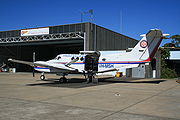
East-West Airlines (Australia)
East-West Airlines was an Australian regional airline founded in Tamworth, New South Wales in 1947. It operated to major regional city-centres and connected these centres to various provincial capitals. It was purchased from its original founders in a share buy-out by Bryan Grey and Duke Minks...
on behalf of the Service. One aircraft was destroyed by fire at Dubbo in 1982 and a fifth Queen Air was added to replace it. In 1985 a fleet modernisation programme began when the first two of four Beechcraft B200C Super King Air
Beechcraft Super King Air
The Beechcraft Super King Air family is part of a line of twin-turboprop aircraft produced by the Beech Aircraft Corporation . The King Air line comprises a number of model series that fall into two families: the Model 90 series, Model 100 series , Model 200 series and Model 300 series...
s were purchased to replace the Queen Airs. In 2003 one of the B200Cs was written off following an accident at Coffs Harbour Airport
Coffs Harbour Airport
-Statistics:The airport currently handles over 26,000 aircraft movements per annum, 5,000 of which are for passenger aircraft.-Operations:-Incidents and accidents:...
. By that time a second re-equipment programme was underway; the remaining three aircraft were replaced that year and in 2004 with four modified B200 King Airs. The Air Ambulance base facility is located at Sydney Airport
Sydney Airport
Sydney Airport may refer to:* Sydney Airport, also known as Kingsford Smith International Airport, in Sydney, Australia* Sydney/J.A. Douglas McCurdy Airport, in Nova Scotia, Canada...
and consists of an aircraft hangar with a light maintenance facility, road ambulance bay, patient care facilities, administration and an area for aircraft parking http://www.ambulance.nsw.gov.au/about_us/ambulance_operations/emergency_response.html#air_ambulance.
The role of the Air Ambulance Service is to provide long distance transport while ensuring the continuation of the patient's medical and nursing care between referring and receiving hospitals. The aircraft becomes the extension of the general hospital ward, Intensive Care Unit, Coronary Care Unit, Labour Ward, Nursery etc.
Air Ambulance operates both a 24-hour emergency service and a routine service. The clinical condition of a patient determines if the transfer is on an urgent or routine basis. An urgent response is provided for patients who require immediate transport, for the clinical management of, for example, multiple trauma, labour complications, acute cardiac cases. A routine response is provided for those patients who are stable and are scheduled for the next routine or elective flight to the area or receiving hospital.
Helicopter operations
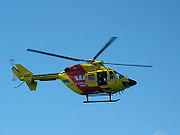
The Ambulance Service of NSW, through the New South Wales Department of Health
New South Wales Department of Health
The New South Wales Department of Health, a department of the New South Wales Government, is responsibile for monitoring the performance of the public health system in New South Wales, particularly through public hospitals...
, has contracts with six medical rescue providers in the State of New South Wales
New South Wales
New South Wales is a state of :Australia, located in the east of the country. It is bordered by Queensland, Victoria and South Australia to the north, south and west respectively. To the east, the state is bordered by the Tasman Sea, which forms part of the Pacific Ocean. New South Wales...
. Each contractor is designated a region of the State and has the option of providing more than one helicopter to their region.
Helicopters operate from Sydney
Sydney
Sydney is the most populous city in Australia and the state capital of New South Wales. Sydney is located on Australia's south-east coast of the Tasman Sea. As of June 2010, the greater metropolitan area had an approximate population of 4.6 million people...
(Rescue 23 and 24 AW139's and Rescue 22 an EC 145), Orange
Orange, New South Wales
Orange is a city in the Central West region of New South Wales, Australia. It is west of the state capital, Sydney, at an altitude of . Orange has an estimated population of 39,329 and the city is a major provincial centre....
(Rescue 21 an EC145 with no winch), Westpac Life Saver Rescue Helicopter Service
Westpac Life Saver Rescue Helicopter Service
The Westpac Life Saver Rescue Helicopter Service was founded in 1973 by Surf Life Saving Australia. Since this time, the Service has carried out more than 50,000 flights ranging from patient transfers to search and rescue missions...
out of the Newcastle (Bell 412
Bell 412
The Bell 412 is a utility helicopter manufactured by Bell Helicopter. It is a development of the Bell 212 model, the major difference being the composite four-blade main rotor.-Design and development:...
, BK 117 with a second Bell 412 arriving early 2011) Tamworth (BK 117 with a second BK 117 arriving early 2011) and Lismore bases ( 2 Eurocopter AS365 Dauphin aircraft), Canberra
Canberra
Canberra is the capital city of Australia. With a population of over 345,000, it is Australia's largest inland city and the eighth-largest city overall. The city is located at the northern end of the Australian Capital Territory , south-west of Sydney, and north-east of Melbourne...
(SouthCare1, a Bell 412) and Wollongong
Wollongong, New South Wales
Wollongong is a seaside city located in the Illawarra region of New South Wales, Australia. It lies on the narrow coastal strip between the Illawarra Escarpment and the Pacific Ocean, 82 kilometres south of Sydney...
(Rescue 26 an AW139).
NSW Health Counter Disaster Unit
Established in 2003, the NSW Health & Ambulance Service Counter Disaster Unit (CDU) consists of specialised NSW Health and Ambulance Service personnel working together to co-ordinate aspects of health disaster planning and response, including responding to terrorism events http://www.ambulance.nsw.gov.au/about_us/ambulance_operations/emergency_response.html#cdu. The role of CDU is to ensure NSW Health is prepared to respond effectively to major health emergencies and disasters within NSW.External links
- Official website
- Paramedics NSW, a ASNSW Employee driven website promoting communication amongst employees
- Air Ambulance Australia

